Hi MDA supporters,
In this July newsletter, our three MDA political fellows give us the lowdown on what it was like covering the recent federal election from the parliamentary press gallery during their placements with The Guardian, the Sydney Morning Herald and AAP. We also spotlight our SMH political fellow, Katherine Wong to hear about her experience as a political reporting ‘newbie’ and her tips for young journos! We introduce the first four women of colour mentorship program pairs in our new annual program cultivating the next wave of editorial leaders. We’re also calling for expressions of interest from early to mid-career Australians of Chinese heritage to undertake an eight-week Secondment program working in mainstream newsrooms. Our 2021 Summer interns reflect on their experiences during their internships. Entries are now open for the 67th Walkley Awards! And finally, we are so proud to announce that our CEO, Mariam Veiszadeh is one of the 12 Community ambassadors for the Racism. It Stops With Me. Campaign.
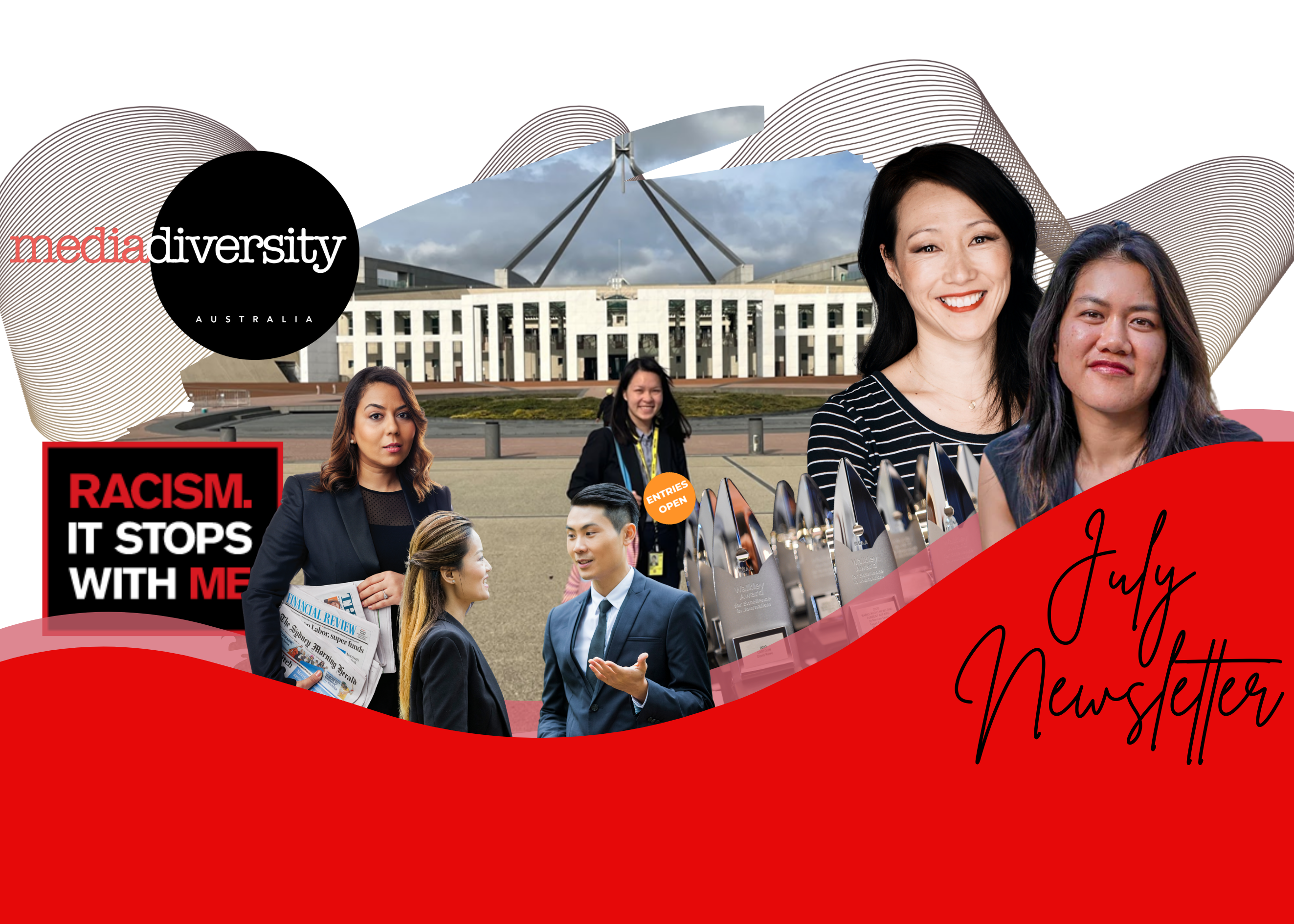
Working in the press gallery was an amazing experience. I had a chance to talk to, and work with, some of the best journalists in the country, and have my work published in one of the biggest print newspapers in the country. To be able to publish my own stories on young people’s perspectives of the election, diverse voices in Australian literature, and even more silly stories about political memes has been a surreal experience. Having the opportunity to write, publish, and learn within the press gallery has further stoked my passion for journalism. While I expected there to be a strong sense of competition and some degree of hostility within the press gallery, I found it wasn’t like that at all. There are so many empathetic journos who understand what it’s like to be a beginner in the industry, and everyone did whatever they could to help me find my feet. It is incredibly inspiring to walk into work everyday and be surrounded by people who are so supportive, lovely, hardworking, and love their job. There are very few places where you can experience this camaraderie.
I’m still in the process of applying for jobs and have received an offer to work in lifestyle media, but I’m trying to get back into a major outlet as soon as I can. I’m still not 100 per cent sure what I want to specialise in or where I want to be, but I know I want to be in journalism. I think I’m leaning towards culture news but since I’m still at the beginning of my career, I want to keep my mind and options open to trying new things. Emerging journos have probably heard this a million times before, but honestly the best tip is to make friends wherever you can. Take any and every opportunity to get lunch or a coffee, don’t be afraid to chat to people while washing your hands in the bathroom, keep in contact with people you’ve met along the way (especially other young journos). These people are the ones you can ask for help, the people who will refer you to opportunities, and who will support you through the rejections we all inevitably have to face.
Media Diversity Australia has been so supportive throughout my experience in the Fellowship. They always reached out to make sure I felt okay in the high-pressure environment of the Press Gallery, and I could always turn to them for honest help and feedback. They understand the difficulties of being a person of colour in journalism which means they know how to help, facilitate connections when needed, and helped validate me when I needed a boost of confidence or felt the weight of imposter syndrome.
MDA’s vision to champion cultural diversity in Australian news and media means helping aspiring journalists get their foot in the door and provide support, so young POC can stay in the industry and wield influence. It means challenging the status quo to dramatically change Australia’s media landscape for the better. It means listening to and actively addressing the concerns of an ever-growing demographic of Australians, and advocating for equal participation for all.
It was really fun finding and successfully pitching stories that initially seemed small and had little coverage before they blew up.For example, finding the story about Robbie Beaton’s false address before it became a full AFP investigation for electoral fraud. Or when I successfully pitched and published a story about territory rights, interviewed four politicians on the issue, before it became a major talking point towards the end of the campaign. These types of stories were really exciting and made me feel like what I was writing had a real impact.
It was surreal to work in the parliament house after spending years studying its significance and working to administer the policies and laws made there. It is also such a beautiful building with lots of gardens and decent food!
I had a lot of fun connecting and making friends with the other fellows
This is a tough one, I absolutely loved every moment of it. The parts that will stick with me forever have to be the feeling of publishing my first story. Seeing my byline up there on the Guardian felt like an accumulation of years of work coming to fruition.
My favourite part of the Fellowship was having the chance to work and pitch in a major newsroom. To have my stories – thought of, pitched, and written completely by myself – read by thousands of people on a national level, is exhilarating. The atmosphere of a newsroom was amazing as well. The hustle and bustle, watching these senior journalists put out 4 or 5 pieces a day and being able to help out with that – it was so cool. I also loved being in the Press Gallery. It was a surprisingly friendly and communal place. Everyone would say hi to each other and stop for chats, journalists would pop in and out of each other’s newsrooms, even the security guards were really friendly.
Pick up the phone, don’t be complacent (there is no time in a newsroom), be brave and have thick skin, write concisely and cleanly, style guides are there for a reason, your network is everything.
These are just some of the valuable lessons I learned in this experience, working with some of the top journalists in the country.
I noticed a real lack of cultural diversity in the AAP Canberra Office, I was the only person of color in the newsroom. The lack of cultural diversity was also reflected in the press gallery more broadly. Everyone at AAP was really lovely and I never felt negatively about being from a diverse cultural background while I was part of their team. It completely felt like a non-issue. However, working in the press gallery/parliament more broadly was a bit overwhelming and I sometimes wondered if I really had a place there.
There was an okay amount in Sydney but none at all in Canberra. It is exactly what I expected so it didn’t make me feel any type of way. However, it could feel like I didn’t belong at times but that being said – getting weird stares from people in the press gallery corridor etc. only strengthened my resolve and made me feel even prouder to be there.
There wasn’t very much diversity in either the Canberra or the Sydney teams. For the most part, this didn’t affect my day-to-day work too much, but I definitely noticed a difference in the way I acted when talking to POC editors and journalists, compared to non-POC members of the newsroom. When I pitched to POC editors, like Osman Faruqi, I felt much more confident and comfortable with my ideas. The process was much easier, and I was less nervous about receiving feedback. However, when I pitched to non-POC editors, I felt like I really needed to prove that my idea was worth pursuing and that people would genuinely read it. It made me feel much more anxious about the entire process.
The Women of Colour Mentorships in partnership with Crescent Foundation, University of Melbourne, and Monash University, is designed to empower First Nations and culturally and linguistically diverse women journalists and provide them with the requisite knowledge and skills to navigate climbing the ranks of editorial leadership.
Meet our first four mentor and mentee pairings…
Antoinette Lattouf (MDA/Journalist/ Author) – MENTOR
Nehal Dalgliesh – MENTEE
Mibenge Nsenduluka (Journalist/Author) – MENTOR
Ruth Brooke – MENTEE
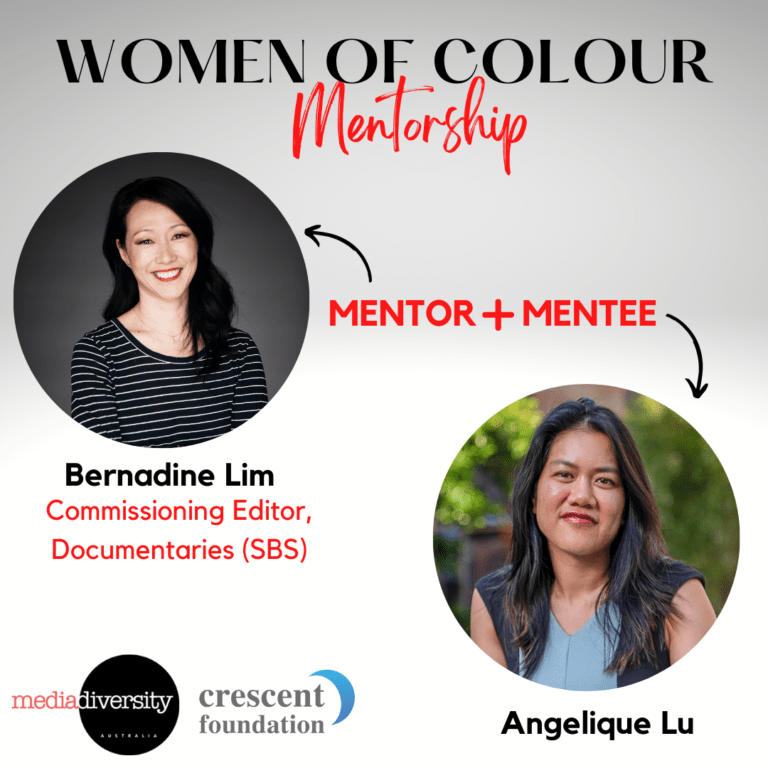
Bernadinr Lim (Commissioning Editor, Documentaries SBS) – MENTOR
Angelique Lu – MENTEE
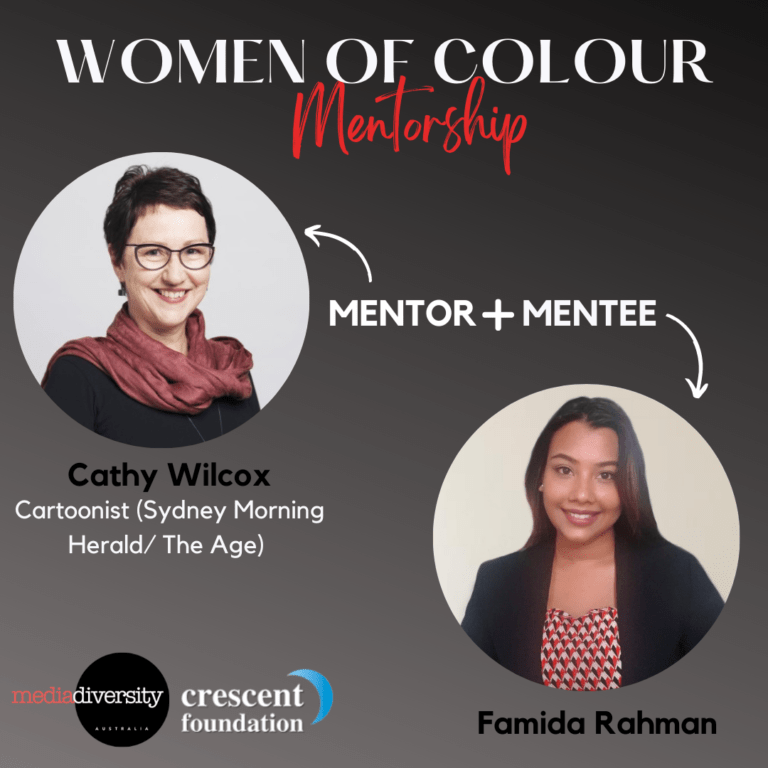
Cathy Wilcox (Cartoonist at SMH/ The Age) – MENTOR
Famida Rahman – MENTEE
Media Diversity Australia is calling for expressions of interest from early to mid-career Australians of Chinese heritage with experience or an interest in working in journalism, to undertake an eight-week program working in mainstream newsrooms.
The eight week program is designed to improve journalism coverage of Chinese communities in Australia, by increasing the number of journalists with strong Chinese cultural connections.
It will provide three Chinese-Australian professionals with the knowledge and skills to navigate the ranks of editorial leadership, and mid-career Chinese-Australians working in other professions with flexible journalism work that may lead to a potential career pivot.
Applicants will preferably have experience working in community media, new media or demonstrated strong writing and/or presentation skills
Applicants can apply by emailing MDA’s Director of Special Projects, Simone Jordan: simone@mediadiversityaustralia.org
For more information on the Chinese- Australian Media Secondment Program visit our website at https://www.mediadiversityaustralia.org/secondment/
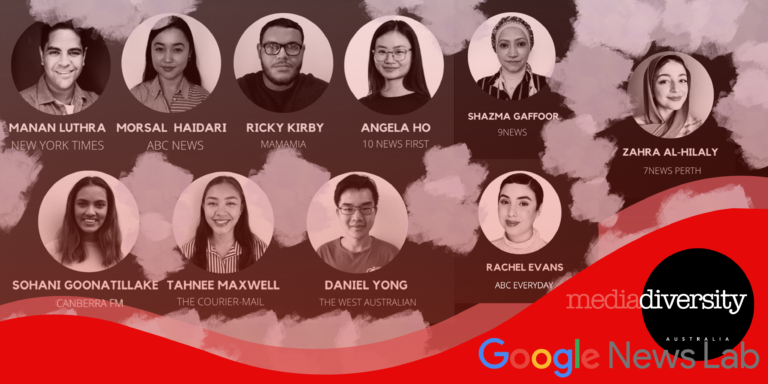
Manan Luthra, The New York Times: “I loved the practical opportunities it provided. Not only was I given the chance to independently produce stories, but I was also given the freedom to find my own sources, conduct interviews with them, and simplify my writing skills to suit a mass audience.”
Ricky Kirby, MammaMia: “My favourite part was having the opportunity to contribute to Mamamia, having something with my name published on their website is really cool.”
Tahnee Maxwell, The Courier-Mail: “I enjoyed being around like-minded people and seeing the way they interpreted news events and then what angles they would come up with. It was also great being around people who supported my future career and encouraged me.”
Angela Ho, 10 News First: “Maybe a more formal scaffold for check-ins with my newsroom manager. There weren’t clearly definable milestones in my internship and I wasn’t sure when I’d have more formal conversations with my newsroom manager about her expectations of me. I think I did well overall, but I wasn’t sure whether there were specific criteria I should have satisfied. My newsroom manager seemed to be happy to let me drive these conversations.”
Rachael Evans, ABC Everyday: “Perhaps a bit more training from the team could’ve been provided, although I never exactly asked. For example, I would’ve loved to watch one of my co-workers do an interview, shadow the subs for a day, run through the style guide, have more insight on how editors edit, etc.”
Shazma Gaffoor, Nine News: “What I least liked was probably the waiting around at the start, but I turned it around and proactively worked towards doing my own packages.”
Zahra Al Hilaly, Seven News: “Next to none. When MDA first mentioned the idea of being paired with a ‘CaLD buddy’ in the workplace I was tempted to say it wouldn’t be necessary, but the reality of turning up on day one in the newsroom to no one else of a different background surprised me more than I thought it would. A similar makeup was observed across different outlets when I met other journalists on-location, so meeting cadets on the road was awesome.”
Morsal Haidari, ABC News Adelaide: “I noticed straight away in the newsroom there was a lack of diversity. I had a childhood friend in the newsroom who is also from the same culture as I, which was very comforting. I realised we were the only people of colour although we fit in the newsroom culture effortlessly.”
Sohani Goonetillake, CanberraFM: “There was a lack of diversity in the newsroom, however, I did feel very welcome from the beginning. Despite our differences, I was fortunate to work in a team with similar values to mine so I felt respected and seen in the workplace.”
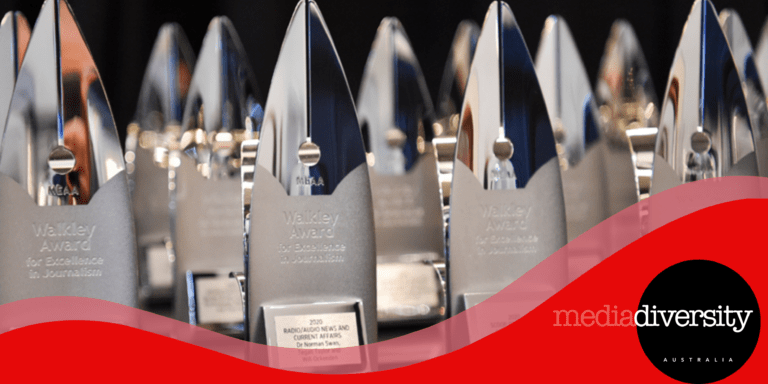
Entries are now open for the 67th Walkley Awards!
The Walkley Awards are open to all Australian media for work published on any platform between September 1, 2021, and August 31, 2022. Entries close at midnight on Tuesday, August 31, 2022. Apply now!
The Walkleys recognise excellence in Australian journalism across 30 categories, on all platforms including photojournalism, documentary, non-fiction books, and cartoons.
You can find all of the categories, terms, conditions and submit your entry here: https://www.walkleys.com/awards/walkleys
Media Diversity Australia is proud to support the Racism. It Stops With Me campaign. Racism is more than just harmful words or individual actions. It includes structural biases in our society, its laws, institutions, and ways of thinking.
We are proud to announce that our CEO, Mariam Veiszadeh was named one of the 12 Community ambassadors of the Racism. It Stops With Me. Campaign
Anti-racism means more than being ‘not racist’. It involves actively committing to taking action against racism, wherever it occurs. That might be in the form of harmful words or actions, but it may also be in the form of structural discrimination in the workplace, or in the justice and health systems, or in the lack of representation in positions of power, such as media, boardrooms or parliaments. Anti-racism means standing shoulder to shoulder with those advocating for justice.
The Australian Human Rights Commission has developed a range of resources, including a conversation guide and Workplace Cultural Diversity Tool, to help people and organisations strengthen their understanding, and develop ways to address racism.
MDA is committed to learning more and taking action. Racial inequality affects all of us, directly or otherwise, and there is a role for us all to play in addressing it. This year’s Racism. It Stops With Me campaign aims to encourage allies to reflect on how racial inequality affects all of us, and take a stand against it. There is a role for everyone to play in addressing racism and begins by asking yourself the hard questions.
As a not-for-profit organisation, we rely on the help of our incredible volunteers. With your financial and volunteer support, we can continue to run programs to support culturally and linguistically diverse journalists, conduct agenda-setting research, run networking events, provide practical solutions for the media industry, and much more. If you would like to make a tax-deductible donation to support the vital work we do, please click here.
Media Diversity Australia (MDA) is a national not-for-profit organisation led by journalists and media professionals. Australia is culturally and linguistically diverse, and our media should be too. Established in 2017, MDA has a unique role as a champion of cultural diversity in Australian journalism and news media. We have a vision for a media industry with full and equal participation for culturally diverse people at all levels.